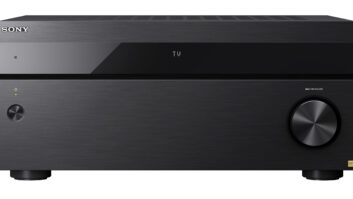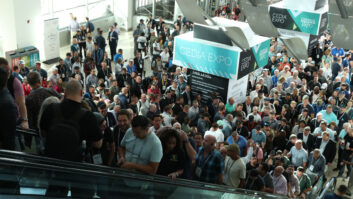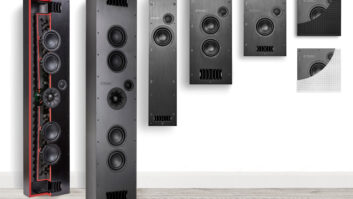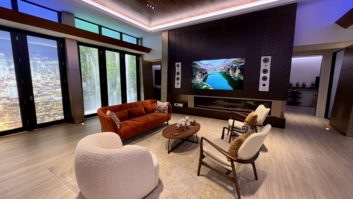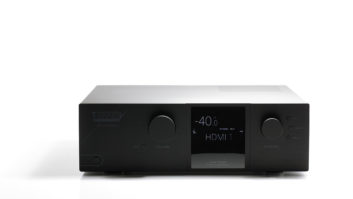Outdoor Home Theaters Offer Great Potential for the Right Client

Above: For Electronics Design Group (EDG) in Piscataway, NJ, a recurring revenue opportunity can involve taking down the key AV components of an outdoor installation in the fall and reinstalling them the following spring. This installation features a SunBriteTV.
It’s hot outside, probably humid, too. Why would anyone want to watch movies outdoors when they can sit in the air-conditioned comfort of the home theater? Because they can, apparently, and they are doing so with increasing regularity.
The outdoor home theater hasn’t become ubiquitous enough yet so that we have to use the adjective “indoor” to distinguish a conventional home heater from some of the growing number of outdoor versions, but sponsored and municipal events like movies in the park in the summers have become popular in many cities and towns in recent years, making the idea of cinema under the stars more familiar in residential settings.
Some integrators have even been able to link outdoor theaters with local sporting events. “We are a big baseball town; clients love the ability to enjoy the outdoors while still catching the game,” says Kevin Burnley, AV design consultant at American TV – Custom Audio Video Design in St. Louis.
It’s also become a useful upsell in an era of more stay-at-home entertainment options, especially if the homeowner wants to turn the rest of the block green with al fresco envy. HiFi House, a Broomall, PA, residential integrator and dealer, is completing a $225,000 project that puts 110-inch Stewart screens on both the inside and outside of a “man cave” built atop a newly renovated garage. Not bad considering the project grew out of a 46-inch SunBriteTV all-weather LCD screen mounted above the client’s outdoor kitchen. All three screens draw content from the same Kaleidescape entertainment server that also supplies the home video displays (and “indoor” home theater) with movies, using a Key Digital video matrix system.
Harry Blanchard, AV systems designer with HiFi House, says over-the-top installations like this one are great fodder for his iPad-stored portfolio of outdoor theaters, which he pulls out when he spots outdoor living areas in clients’ homes.
When consumers can access more and more home theater technology at Wal-Mart and Best Buy, the outdoor theater offers some useful barriers to the DIYers. Take, for instance, keeping technology assets out of meteorological harm’s way. He used Lutron QS low-voltage motors to roll up the indoor and outdoor screens in the garage “cave” to address safety and reliability issues, and fabricated an umbilical connecting AC power and component AV cabling to the video server, allowing the owner to plug in the Sony VPL-VWPRO1 outdoor projector with a single move.

A theater HomeTronics did last year for a local sports entrepreneur in Dallas has a 25×14-foot Da-Lite screen housed in a motorized compartment that forms a header on one side of a massive training facility the client constructed adjacent to his residence for his youth basketball team.
But much of the demand for outside theaters is coming from more modest aspiring outdoor cineastes. “In the last year or so, there’s been more product choices than ever before” for outdoor theaters, Blanchard said, noting the SunBriteTV and Ciil (pronounced “seal”) weatherproof LCDs he’s been selling. SunBriteTVs are now available in sizes up to 55 inches, and the more expensive Ciils are his choice when the design requires the display to be absolutely waterproof. Manufacturers also have become more aware of the aesthetic of the display itself, which is helping sell the idea of the outdoor theater.
“A big change from years ago is that you no longer have to use displays that are set into industrial-type enclosures,” he added, noting that LCDs also allow better viewing than projected images in higher ambient light environments, a key point when summer sunsets come later and later. Slimmed-down bezels are making their way from digital signage applications to residential ones. “Otherwise you could use regular plasmas or LCDs outside but you had to install them under a roof or an overhang to protect them, and you had to deinstall them and bring them inside for the winter,” Blanchard said. “Now, we have products that can stay out there all year long, and work from -14 degrees to +125 degrees and look good doing it. That’s a selling point.”
Under A Big Sky
Decisions about outdoor home theaters are implicitly tied to local environment. Clients in regions with long, hot, and humid summers might be less enthusiastic about the idea than those living in Southern California. Bryan Cruikshank, vice president of integration company HomeTronics, in the Dallas area, says Texas’ sometimes capricious meteorology can make the outdoor home theater a harder sell. But like much else in Texas, when a client does go for the outdoor home cinema, it can be pretty over the top.
A theater HomeTronics did last year for a local sports entrepreneur has a 25×14-foot Da-Lite screen housed in a motorized compartment that forms a header on one side of a massive training facility the client constructed adjacent to his residence for his youth basketball team. Across a long rectangular pool fed by fountains that double as subwoofer housings, a rustic porched fishing shack has a Runco MXB1 projector in its attic, covered by a manually opened hatch. The shack also holds another subwoofer and the AV rack with its NAD T175 processor and ATI balanced amplifiers. Other displays are three 65-inch Sharp LC-65E77U LCDs and a SunBriteTV 4610HD LCD. The system also includes other amenities like the AMX 8.5-inch and five-inch WiFi-based remote controls, 20 pairs of Near A6 speakers for multiroom audio around the patio, and video sources including a Samsung Blu-ray player, two DirecTV boxes, and a connection to the main house’s Kaleidescape media server.
The LCR array of the surround sound system is tucked behind the same soffit that holds the rolled screen, with the surround speakers mounted on either side of the fish shack projection booth. The speakers are custom made by California Audio Technologies (CAT) based on Cruikshank’s specifications that called for aluminum drivers and Avonite fascia on the enclosures, both used to minimize the effects of moisture from humidity and the pool area.
All cabling is direct-buried, run in conduit under the patio area and around the pool. The fitness facility has its own isolation ground and surge protection, and the AV gear runs off of its AC power, which Cruikshank says assures cleaner power, no spikes and increased reliability and longevity for the equipment, something that also reassures the client.
Cruikshank’s HomeTronics business partner Greg Margolis says the challenge in outdoor theaters like this is presenting them as practical propositions to the typically pragmatic Texan client. “They’ll rationalize it according to how much they think they might use it, and given Texas’ weather there’s not that many days, really, compared to the west coast,” he said.
But, adds Cruikshank, the trick is to get those clients to see one like this. Even if it’s well beyond their budget, he said, it gets them thinking about the idea. At the very least, it’s led to many indoor projects being expanded to include pre-wiring for a future outdoor theater addition.
Birds and the Bees
If weather is an issue, often so is nature. Matt Bolger, project manager at Electronics Design Group (EDG) in Piscataway, NJ, says birds like to build nests in surface-mount speaker locations. Bees and wasps seem to like rock speakers for similar reasons. These kinds of interactions with wildlife can lead to customer dissatisfaction and return visits for the integrator in the role of “critter-ridder.”

The urban outdoor home theater has arrived, though Audio Video Design’s president Brad Smith is realistic enough to know that not many rooftops or backyards in Boston are going to become candidates for this kind of treatment.
As a result of these kinds of experiences, Bolger steers clients away from surface-mount speakers. Instead, he’ll look for alternative locations that keep them out of sight for aesthetic and wildlife reasons. One such solution is to attach an outdoor speaker to a rebar-reinforced 4×4 piece of lumber that’s placed inside a bush or other bit of landscaping. To keeps insects out of AV gear, he’s used weatherproofed rubber gasket material around the edges of retractable displays and other in-andout mechanical systems. Cabling for outdoor AV has to meet the sometimes-contradictory criteria of being both tightly sealed against moisture and accessible for servicing.
On an outdoor theater project in Hamilton, NJ, last year, in which a SunBriteTV SB-4610HD 46-inch LCD all-weather outdoor TV is recessed when not in use into part of the concrete outdoor cooking station, Bolger designed the cable runs and EV connections into the same cavity as (wellsealed) gas lines, and they can be accessed through the same aluminum cabinetry doors on the cooking station.
That $35,000 project, which included the inhome media room and some multizone audio, is typical of the outdoor theaters that integrators will do in the Northeast, Bolger said, where a recurring revenue opportunity can involve taking down the key AV components in the fall and reinstalling them the following spring, which can bring in anywhere from $750 to as much as $5,000, depending on the amount of equipment and the complexity of the outdoor systems.
Up On the Roof
An outdoor theater that Audio Video Design of Boston created in that city’s now-fashionable South Bay district does not have to come inside for the winter. On the roof of the client’s home, a SunBriteTV 4610 display is secured inside a custombuilt cabinet that also holds a Marantz SR5003 AV receiver, Pioneer BDP-320 Blu-ray player, an iPod dock and three Niles OS6.3 outdoor speakers in an L-C-R array beneath the screen. Two more Niles OS6.3 speakers are tucked behind a trellis behind the seating area as the surrounds, and another 10 are hidden around the roof entertainment area.
The urban outdoor home theater has arrived, though Audio Video Design’s president Brad Smith is realistic enough to know that not many rooftops or backyards in Boston are going to become candidates for this kind of treatment; if it’s not the Boston winters then it will be the ingrained conservatism of the Brahmin clientele that won’t embrace the concept, he said. But the Southie neighborhood, like other gentrified sections of other cities, offers some hipster potential to bring the outdoor cinema to a rooftop near you.
The way this one came about could be typical. Smith recalled that the residence owner wanted to use his rooftop for extensive entertaining and was planning on moving standing speakers outside for events and then taking then back in when they finished. Smith suggested that this could get tiresome after a while and perhaps something a bit more permanent could be designed. Instead of the two large speakers the client had envisioned, Smith recommended a version of the distributed sound systems now common at sports venues, with smaller Niles speakers located throughout the area to provide full coverage at lower volumes. Keeping noise contained was also why the theater’s sound has no subwoofer, since bass frequencies would travel the furthest and potentially attract visits from Boston’s Finest.
Urban rooftops are often crime targets so the theater cabinet’s openings have closure contacts connected to the home’s security system. The installation looks neat too, with some of the cabling run beneath the decking and all of the video and audio sources inside a cabinet. But wiring to the distributed speakers are exposed, and Smith chose to paint them rather than run conduit, in part to keep the entire AV installation, including a more audiophile system in the house, within the $17,000 budget for the project.
Urban rooftops are often crime targets so the theater cabinet’s openings have closure contacts connected to the home’s security system. The installation looks neat too, with some of the cabling run beneath the decking and all of the video and audio sources inside a cabinet. But wiring to the distributed speakers are exposed, and Smith chose to paint them rather than run conduit, in part to keep the entire AV installation, including a more audiophile system in the house, within the $17,000 budget for the project.
Dan Daley is a freelance writer based in Nashville, TN.


